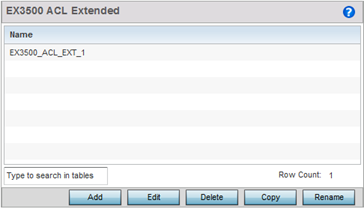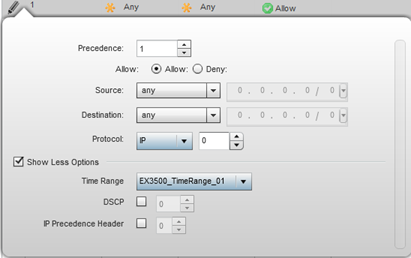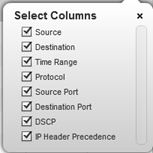| Precedence |
Specify or modify a precedence for
this ACL between 1-128. Rules with lower precedence are
always applied to packets first. If modifying a precedence
to apply a higher integer, it will move down the table to
reflect its lower priority. |
| Action |
Every ACL rule is made up of
matching criteria rules. The action defines the action to be
performed if it matches the specified criteria. The
following actions are supported:
- Deny - Instructs the firewall to
restrict a packet from proceeding to its
destination.
- Permit - Instructs the firewall
to allow a packet to proceed to its
destination.
|
| Source |
Use this drop-down menu to provide
the source information. Source IP address can be one of Any,
Host, or Network. When selecting Host provide the IP address
of the host device. When selecting Network, provide the IP
address of the network along with the mask. |
| Destination |
Use this drop-down menu to provide
the destination information. Destination IP address can be
one of Any, Host or Network. When selecting Host provide the
IP address of the host device. When selecting Network,
provide the IP address of the network along with the
mask. |
| Protocol |
Set a service alias as a set of
configurations consisting of protocol and port mappings.
Both source and destination ports are configurable.
Depending on the selected protocol, other fields might
become visible and can be configured. |
| Time Range |
Use the drop-down menu to
configure a time range when this ACL is applicable. For more
information on configuring time ranges, see EX3500 Time Range. |
| DSCP |
Differentiated Services Code Point is a
mechanism that specifies a simple mechanism for classifying
and manage network traffic and provide a QoS mechanism. Use
the spinner to select a value in the range 0-63. Use this
value to classify and mark packets that match the criteria
specified in this extended ACL rule. Either DSCP or IP Header
Precedence can be configured. The two
fields cannot be configured together.
|
| IP Header Precedence |
Use this field to set the
precedence value in the IP Header. Use the spinner to select
a value in the range 0-7. Use this value to classify and
mark packets that match the criteria specified in this
extended ACL rule. Either DSCP
or IP
Header Precedence can be configured. The
two fields cannot be configured together.
|







